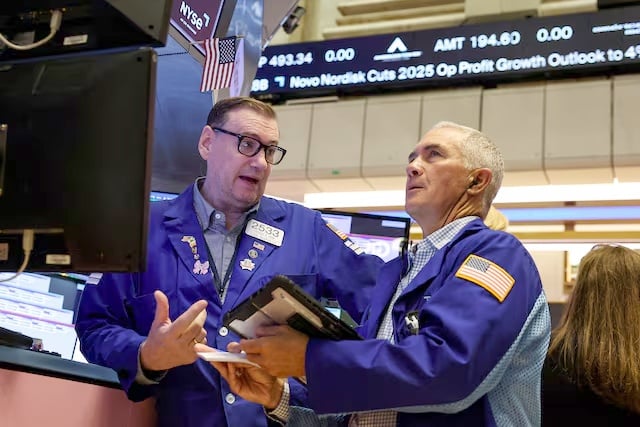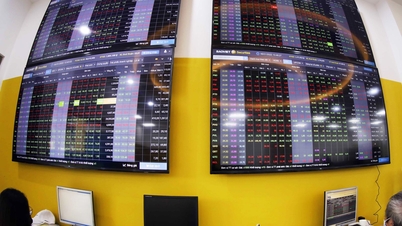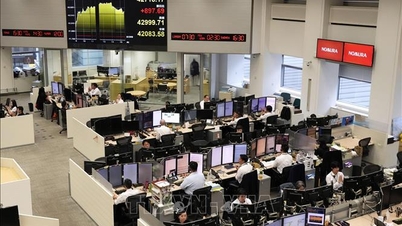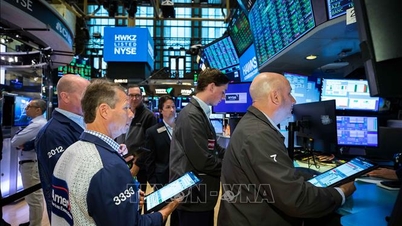 |
| Positive data eases valuation concerns, US stocks remain green |
The improvement in sentiment came from better-than-expected employment and service activity data, suggesting the US economy remains resilient despite concerns about input costs and a softening labor market. Along with that, the third-quarter earnings season continues to be an important support as most businesses beat Wall Street forecasts.
After a strong sell-off on November 4, when many technology and semiconductor stocks plunged due to profit-taking pressure after a series of hot increases, the November 5 session marked the return of cash flow, albeit with a rather cautious attitude. Concerns related to the "sky-high" valuation of the technology group have made investors cautious, with some major bank leaders even warning about the possibility of a market reversal.
Oliver Pursche, Senior Vice President at Wealthspire Advisors, said that a short-term correction of 10% to 15% is entirely possible, but he also emphasized that the current sentiment is still "buy the correction" due to confidence in the market's long-term uptrend.
However, the session's gains cooled somewhat after JPMorgan Chase CEO Jamie Dimon told Reuters about the risk of a market downturn as asset prices are currently high.
The ADP employment report showed private payrolls rose by 42,000 in October, better than expected, but weakness in some sectors suggested the labor market was not as strong as it had been. Service sector data also showed positive expansion, but input costs rose to a near three-year high.
In addition to economic risks, the policy environment is adding pressure. The US Supreme Court has ruled on the legality of previous tariffs imposed by former President Donald Trump, a move that could affect global trade. Beijing has announced partial rollbacks of retaliatory tariffs but has maintained significant tariffs on US goods, including a 13% levy on soybeans.
Meanwhile, the stagnation of Congress , which has led to the risk of a prolonged US government shutdown, is a factor that could negatively impact investment sentiment and corporate financing costs.
According to LSEG statistics, 379 companies in the S&P 500 have announced profit reports, with 83% exceeding forecasts. Third-quarter profit growth for the entire S&P 500 is expected to reach 16.2% compared to the same period last year, double the expectation at the beginning of the quarter.
Peter Tuz – President of Chase Investment Counsel commented positively: “Revenue and profit both brought surprises. Although the economy has shown signs of weakening in some indicators, the market is still receiving important support.”
Thanks to that, many stocks have increased sharply: - McDonald's rose 2.2% on sales that beat forecasts - Match Group up 5.2% despite cautious outlook - Amgen rose nearly 7.8% on better-than-expected profit - Johnson Controls jumps 8.8% after positive 2026 guidance |
Trading volume reached only 19.17 billion shares, lower than the average of the last 20 days (20.96 billion shares). Although the number of increasing codes still overwhelmed the number of decreasing codes, the level of participation of cash flow showed that investors were still probing the market.
On the Nasdaq, 3,006 stocks rose and 1,631 stocks fell, a ratio of 1.84:1. The S&P 500 recorded 25 new 52-week highs but also had 16 new lows, reflecting a growing divergence.
The November 5 session was seen as a stabilizing moment for Wall Street after a major shake-up in the tech sector. Valuation concerns have not disappeared, but positive economic data and earnings reports are keeping the market on track.
For investors, this is a time to be more selective, focusing on businesses with solid foundations, avoiding large bets on stocks that have increased sharply. More cautious and strategic actions can help overcome the potentially volatile period in the coming time.
Source: https://thoibaonganhang.vn/pho-wall-hoi-phuc-nhe-nho-loi-nhuan-vung-chac-cong-nghe-dan-nhip-tang-tro-lai-173140.html




![[Photo] Closing of the 14th Conference of the 13th Party Central Committee](https://vphoto.vietnam.vn/thumb/1200x675/vietnam/resource/IMAGE/2025/11/06/1762404919012_a1-bnd-5975-5183-jpg.webp)
![[Photo] Prime Minister Pham Minh Chinh receives the delegation of the Semiconductor Manufacturing International (SEMI)](https://vphoto.vietnam.vn/thumb/1200x675/vietnam/resource/IMAGE/2025/11/06/1762434628831_dsc-0219-jpg.webp)














































































































Comment (0)